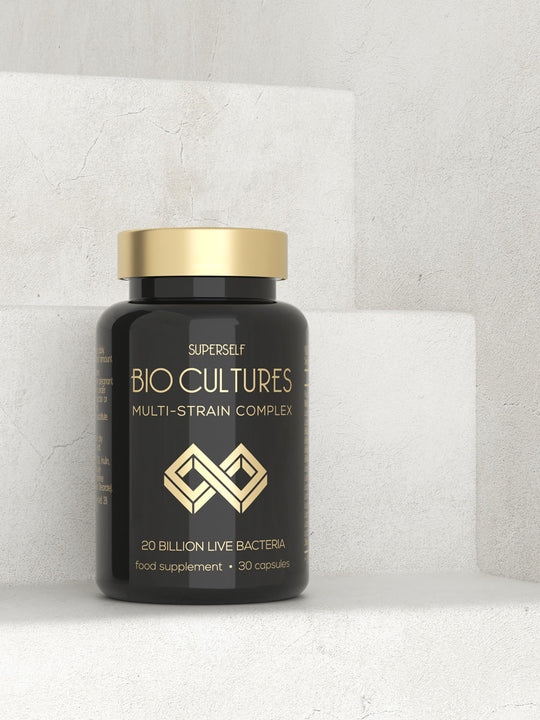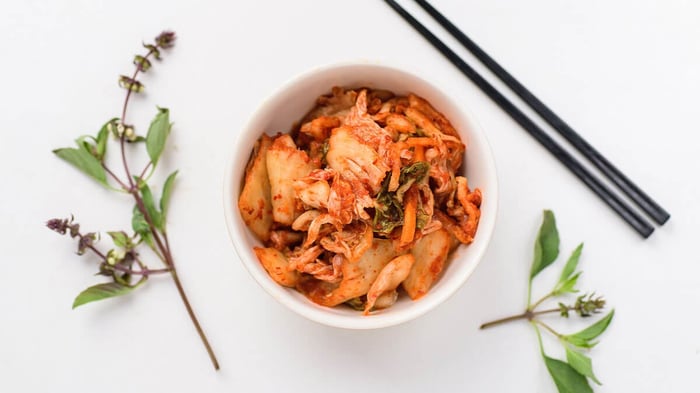Probiotic foods are foods that naturally contain beneficial bacteria. Once eaten, probiotics continue to live in the gut where they help break down food, generate nutrients, and provide other benefits: research has suggested that a healthy gut biome can improve digestive health, metabolism, immune system, and other mental and physical health issues. While keeping bad bacteria (such as salmonella, listeria and others) out of human food has always been a major concern, modern industrial food production methods may swing too far the other way, destroying beneficial bacteria along with harmful ones. This means that you may have to look harder to find probiotic foods, but they definitely exist. Here are a few of our favourites.
1. Yoghurt
Yogurt wouldn’t be possible without bacteria: it’s made by them transforming milk. Typically, yogurt is made using lactic acid bacteria and bifidobacteria. While many yogurts are pasteurised, which kills the bacteria but increases shelf life, or has a lot of added sugar, which has a similar effect, ‘active’ or ‘live culture’ yogurts with a low sugar content are a great probiotic and available in most supermarkets.
2. Kefir

Another fermented milk product, kefir is a drink made by adding a kefir starter to cow or goat milk. The traditional kefir starter is known as ‘kefir grains’ because the bacteria and yeast form clumps which look something like crumbled cauliflower. They can contain up to 61 different species. Originating from the Caucasus area, it was popular in Russia and Turkey before being discovered by the rest of the world. Today, it is popular in Asia and Europe as many people who are lactose intolerant find they can drink it with no ill effects. As with yogurt, look for ‘live’ or ‘active’ kefir in the supermarket.
3. Kombucha
With a history stretching back over 2,000 years, kombucha is a fermented black tea product originally developed in China. Over the last hundred years, it has spread through Europe and the US, and can now be found in many supermarkets. Kombucha is simple to make at home as the starter (known as a SCOBY, a symbiotic colony of bacteria and yeast) can be ordered online. Like many fermented products, kombucha can become alcoholic if not properly prepared, but commercial brands are carefully tested to ensure they remain non-alcoholic. You can find ‘live’ kombucha in most supermarkets, alongside other fizzy drinks.
4. Kimchi
A traditional Korean dish, kimchi is still often made at home. As a result, there are thousands of recipes using a wide range of vegetables, spices and other ingredients. Cabbage and radishes are among the most common, with ginger, pepper, and seafood often being added. Brining salt is used to restrict the growth of bad bacteria while encouraging the growth of good bacteria essential to the fermentation process. No starter is used – kimchi gets its flavour and probiotic goodness from the vegetables and other ingredients used. Look for ‘raw’ or ‘live’ kimchi in the supermarket or a specialist store.
5. Natto

A staple in Japanese kitchens, natto has a distinctive smell and a strong flavour. Made from fermented soybeans, it is popular as a breakfast food and is often served with rice. It has been traditionally viewed as a healthy product, and today we know it is rich in protein and vitamin K2, as well as being a probiotic. Thanks to its unusual texture, smell and flavour, it is uncommon outside Japan but may be found in specialist shops.
6. Miso
Used as a seasoning, miso is made by fermenting soybeans. Outside Japan, it’s most commonly served as a soup. Miso soup is easy to make at home, but if you’re looking for the probiotic benefits you need to use a live culture miso and cook it carefully to avoid killing the good bacteria. While most supermarkets will offer a shelf-stable (and therefore probably pasteurised) miso soup mix powder, you may have to look online or in a specialist store to find a live miso paste.
7. Sauerkraut
Literally ‘sour cabbage’, sauerkraut is a pickled cabbage dish. Originally from Germany, it has spread throughout Europe, with regional variations having different flavours and possibly additions such as carrots or herbs. Easy to make at home, in its simplest form shredded cabbage is salted and left to ferment. Sauerkraut is available in most supermarkets, however, it is often pasteurised. Look for ‘raw’ or ‘live’ versions, which may be more common in specialist stores, such as Polish food shops.
8. Tempeh
Another fermented soybean product, tempeh is made with a yeast starter. Originally from Indonesia, it is suitable for vegans and has a rich flavour and meaty texture, making it a popular meat substitute. Tempeh used this way is often highly processed, pasteurised and/or cooked at high temperatures (e.g. fried) all of which will kill the good bacteria. To find a probiotic source, you may have to skip supermarket tempeh and head to a specialist shop.
9. Cheese

Found in almost every shop in the UK, cheese may be the most commonly overlooked source of probiotics. While it has a very different texture and flavour, cheese is technically a fermented milk product, made by the action of bacteria and yeast. Like many other milk products, it can be made from pasteurised milk or heat-treated at various points to eliminate the bacteria and prolong shelf life. For this reason, if you’re looking for a probiotic cheese, look for one made from ‘raw’ or ‘unpasteurized’ milk. Soft cheeses provide a more hospitable home for bacteria, which means you’re likely to only find pasteurised versions in the supermarket. Farmers' markets, farm shops and specialist cheese shops may sell fresh soft cheeses with live bacteria. Mould ripened cheeses, such as Brie or Camembert which continue to develop are an exception and commonly available. Hard cheeses made in the traditional way from raw milk, such as Gruyère, a traditional Gouda or small-batch cheddar, combine both a long shelf life and intact probiotics, which means they may be the easiest to find.
10. Other pickles
Pickled onions, pickled cucumbers (often known as gherkins, cornichon or simply ‘pickles’), pickled beetroot, pickled lemons … there are so many options out there. Pickling is a traditional method of preservation which lets vegetables, fruit, seafood or other foods ferment in brine (salt water) or vinegar. Vinegar tends to halt the action of bacteria, so look for brine pickles. While many supermarket brands will have been pasteurised during production, ‘live’, ‘raw’ or ‘active’ pickles can be a good source of probiotics. And, of course, you can make your own at home using whatever ingredients, spices and seasonings take your fancy as you’ll find dozens of recipes online.
Probiotics for fussy eaters
If you eat a wide range of natural foods or cook a lot, you’ll probably already have a number of good sources of probiotics in your diet and may find it easy to add more, despite their strong or novel tastes. If, however, you’re catering for someone with a more restricted diet, whether that’s restricted by a medical condition, religious needs, allergies or simple preference, then finding good probiotics can be harder. In this case, you might turn to a flavoured probiotic drink or a good quality supplement. Tasteless and odourless, SuperSelf probiotic capsules contain over 20 billion live bacteria in each dose, from carefully selected strains of good bacteria. Pairing your probiotic with a prebiotic, a food that feeds the bacteria, can be a great way of increasing the impact of your probiotic. Prebiotic foods are typically high in fibre and include whole wheat flour, bananas, oats (preferably raw, e.g. in granola), whole grain breakfast cereals and some greens and vegetables.
Probiotics Bio Cultures Complex 20 billion CFU - 30 Capsules

£14.90
Modern stresses, including antibiotics, infection and travel, can compromise gut flora. This SuperSelf blend of friendly bacteria cultures provides an easy way to revitalize your natural gut flora. Blend of 15 well-researched lactobacillus and bifidobacterium bacteria High potency: 20 billion… Read More


